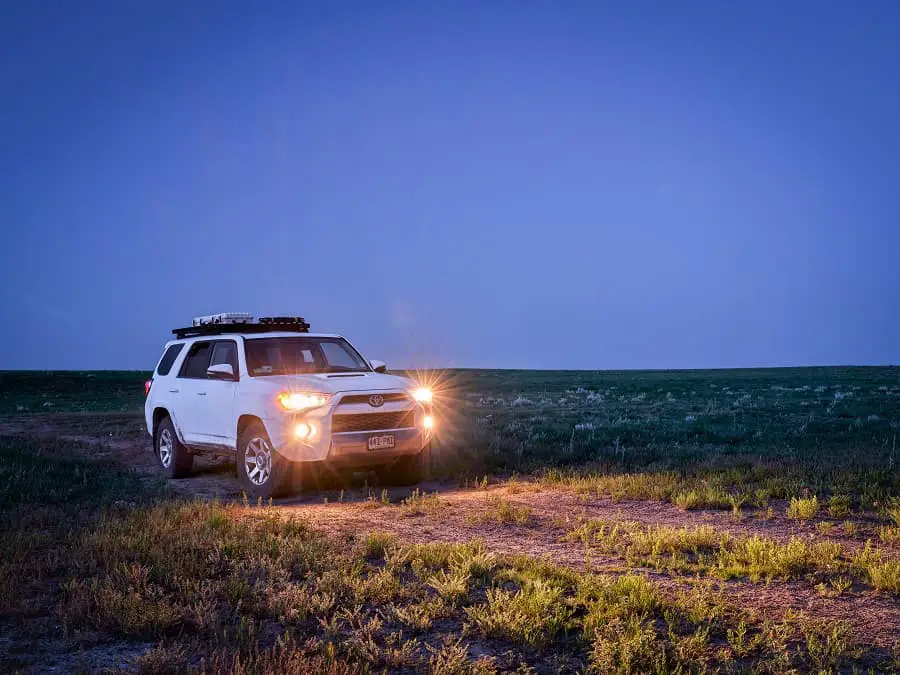
Nighttime is the most dangerous time to drive, mainly because of low visibility that makes it difficult to navigate while on the road. The National Highway Traffic Safety Administration reveals that 51% of all fatal motor vehicle crashes in 2019 happened during nighttime, especially on Saturday nights.
But you can’t deny the fact that peaceful surroundings, cool breeze, and beautiful night sky make nighttime the perfect time for a road trip. To enjoy the road at night and avoid unwanted road accidents, here are 15 safety tips for night driving.
- Aim Headlights Correctly
- Reduce Speed
- Minimize Distractions
- Wear Anti-Reflective Glasses
- Stay Alert
- Look Away from On-coming Lights
- Stay Awake
- Use a Map for Easy Navigation
- Equip Vehicles with Repair Tools
- Use Exterior Lights Properly
- Watch Out for Wildlife on the Road
- Clean Windshield and Headlights
- Keep a Safe Following Distance
- Drive Sober
- Dim Interior Lights
So, that is it, easy peasy. But let’s take a closer look at each to keep you safe when out on the road or trail at night.
1. Aim Headlights Correctly
The headlights of your vehicle are your eyes to see clearly what’s on the road ahead of you while you drive at night. It is crucial that you set your headlights at an angle that gives you enough light to illuminate your path, but not so bright that it blinds oncoming drivers.
This means that they should not be tilted too low or too high. Turn on your high beams when you are driving in isolated and very dark areas. Switch to low beams when there are oncoming drivers or there are vehicles behind you, so you don’t blind them and cause distraction in their driving.
2. Reduce Speed
Many road accidents involve driving above the speed limit. This is illegal and is not only dangerous to the person driving the vehicle, but also to other drivers driving on the same road. The faster the vehicle, the longer it would take to slow down in the event of sudden obstacles on the road.
It is wise and recommended to reduce your speed while you drive in dark areas so it will be easier for you to control your vehicle. Reduce your speed according to the road conditions you are driving on. Reduce it by one-third if the road is wet and by one-half, if it’s snowing.
3. Minimize Distractions
Distractions are the number one enemy you have to defeat while you are driving at night. Because you have limited vision, your focus must only be on the road and not somewhere else, like your cellphone. Even in shows and movies, the most common cause of road accidents is having to respond to calls and text messages. However, receiving important calls and messages when you are driving is inevitable.
Drivemode can help you keep your focus on the road despite incoming calls and texts with its hands-free messaging and calling features for safe night driving.
4. Wear Glasses That Are Anti-Reflective
Reflections from streetlights and oncoming vehicles can cause eyeglass glare, especially if what you’re wearing is the typical prescription eyeglasses. This reflection can block your view and further reduce your limited vision on the road. This is dangerous, especially when the oncoming vehicle is driving at the above speed limit. In this case, an eyeglass that has an anti-reflective coating like PolarSpex HD+ Amber Driving Glasses can save your life. The anti-reflective coating eliminates the reflection from bright streetlights and gives you a sharper vision at night. They come in many styles and colors.
5. Stay Alert
Most people actually avoid driving at night. Having no idea of what is happening around you and the fear of something suddenly appearing in the middle of the road can be really scary and discouraging. But this fear can easily be removed by being extra vigilant while driving at night.
You can see everything that is happening near you by just paying attention to your mirrors. Make sure that they are clean and angled in such a way that they can give you a clear view of what’s on your side and what’s on your back. Keep an eye out for vehicles near you because most of the time, their faults will be the cause of accidents and not yours.
6. Look Away From Oncoming Lights
Bright headlights from oncoming vehicles can blind you and instantly distract you from your driving. That short time of you getting distracted is enough to cause accidents especially, when you are approaching an intersection or a curve in the road. Do not stare at the oncoming headlights, and keep your focus on your driving. Keep your eyes down and to the right. When the vehicle has already passed, you can now lift your gaze back up.
7. Stay Awake
You’ve probably heard and read about this reminder a lot, but you’ll be surprised at how many people still drive despite feeling sleepy. In fact, drowsy driving is a leading cause of road accidents, aside from speeding and distracted driving. Stay awake! If you find it really difficult to stay awake because of fatigue, pull over and take a short nap. Think of what you usually do whenever you have to fight the urge to sleep. Below are some tips on how to stay awake while driving at night.
- play some music
- listen to the radio
- drink coffee
- do jumping jacks
- pull over, get out of the car and do stretching
- roll the windows down and breathe some fresh air
- talk to someone in the car
- listen to audio book
- listen to podcasts
8. Use a Map for Easy Navigation
When you drive at night, the only area that you have a clear view of is the road ahead of you. You won’t be able to find landmarks in the dark to pinpoint which road you should take. For easy navigation at night, seek help from our recent article The Best GPS Navigation App so you still have an image of your track without having the need to pull over just to find a location easily. The GPS navigation system will tell you which way to go, possible traffic that can interfere in your road trip, your location, and landmarks near you.
9. Equip Vehicle With Repair Tools
Driving at night can be really challenging, especially when your car suddenly acts up in the middle of nowhere and it’s dark around you. Make sure that you have in the car tools that can make you do simple repairs. In the event of a flat tire, you should have an air compressor to fix it. You don’t want to get stranded in the dark where help is uncertain. Always check that you have the tools to fix car troubles on the road.
10. Use Exterior Lights Properly
A rule of thumb when driving at night is to make your vehicle as visible as possible. The headlights of your vehicle are not your only source of light. You can also upgrade or install the lighting system on the rear, side, and top of your vehicle to increase your visibility. If you end up stranded on a highway at night, use these exterior lights properly to mark your territory and signal for help to passing vehicles.
You can check out our article on LED lights, and give LED lights a try because they are energy-efficient and the brightest.
11. Watch out for Wildlife on the Road
When driving in remote places at night, chances are you’ll encounter wildlife in the middle of the road. You have to be alert for this type of obstacle because these animals are harmless and only want to cross the road. This is why it’s important that you reduce your speed at night so you can easily stop the vehicle and avoid harming these animals.
12. Clean Up Windshield and Headlights
It is important that you also clear your view by ensuring that your windshield and headlights are in great condition. Damaged headlights produce less light, and a dirty windshield can make it difficult for you to see the road ahead. The combination of these two can decrease your visibility and make you at risk of road accidents. If you think that your headlights need restoration, the Sylvania Headlight Restoration Kit is a cleaning kit you can rely on.
13. Keep a Safe Following Distance
It is dangerous if you drive too close to the vehicle in front of you, same with the vehicle in the back of you. Maintain a distance enough to give you space to not hit the car in front of you when it suddenly stops. The National Safety Council recommends a minimum three-second following distance rule for safe night driving. To give you a clearer definition of the three-second following distance, look for a tree or any landmark on the road ahead of you.
Take note when the vehicle in front of you passes that tree. Then from there, determine how long it takes you to pass it. If it’s less than 3 seconds, slow down to increase your following distance.
14. Drive Sober
If it’s difficult to walk straight while you’re under the influence of alcohol, it’s the same with navigating the road while drunk. As the National Highway Traffic Safety Administration says, “Drive sober or Get Pulled Over.” It’s hard to concentrate and stay alert while you are drunk. If you drive in that state, you not only put yourself at risk of accidents but also the people around you. Navigating at night will be 10 times more difficult and dangerous when you’re drunk. Drive sober.
15. Dim Interior Lights
Dashboard lights that are too bright are as distracting as your ringing phone. It is best to dim your interior lights so you don’t get disoriented when you look back on the road after taking a glance at your dashboard for metrics. Interior lights can help you stay awake and alert, but if they’re too bright, they can be a distraction to your driving.
Takeaways
It is challenging to drive at night because it’s difficult to navigate when all you see is darkness. Do not let this stop you from discovering the beauty of the night. For safe night driving, take note of all the 15 safety tips for night driving mentioned above, and what once was scary will be fun.

